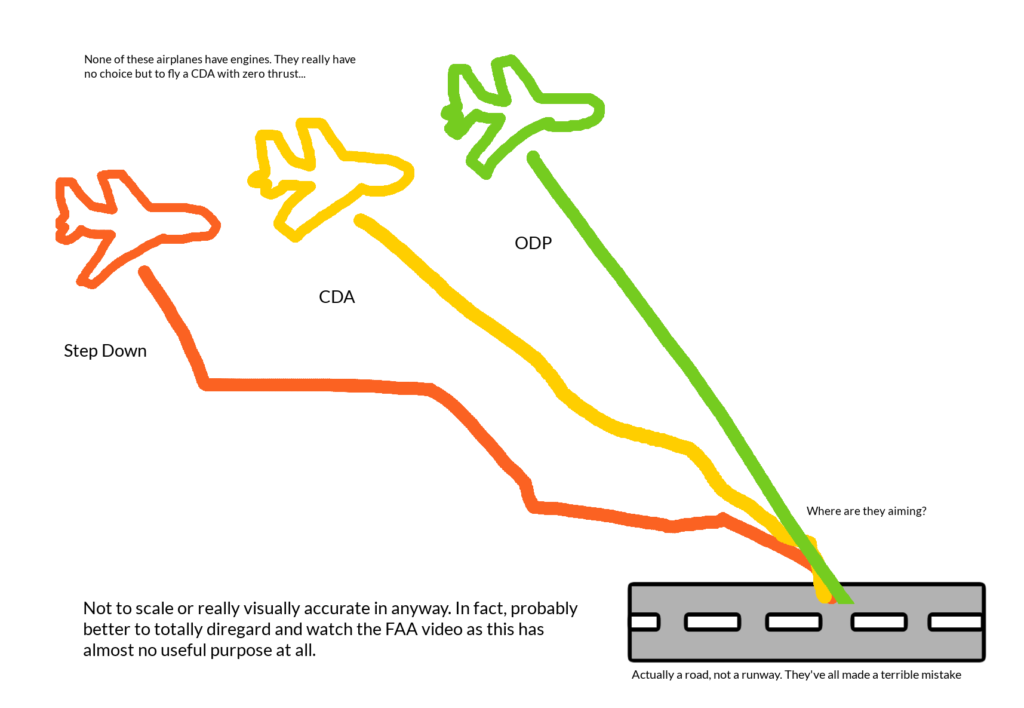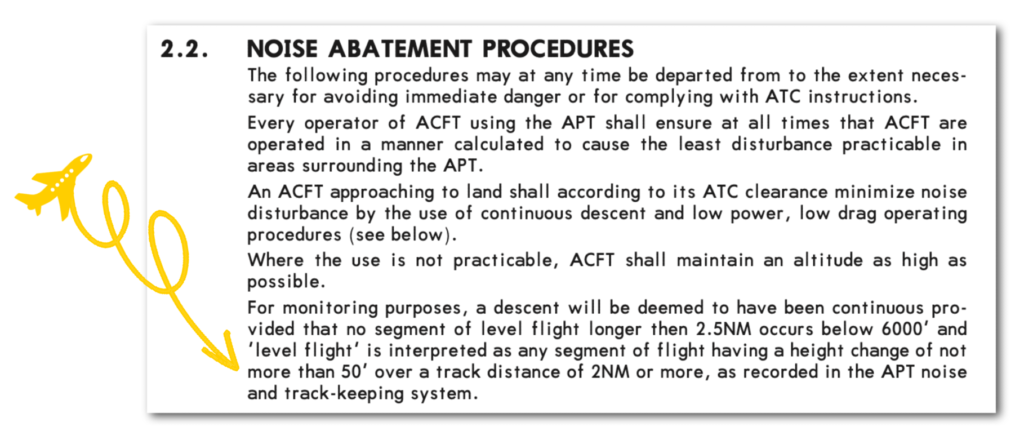Thee FAA has ‘stepped up’ their game in reducing emissions and save fuel by reducing the number of ‘step down’ approaches into some major airports.
Here is a mini ‘what you need to know’ about CDAs, OPDs and how and where to fly them.
What’s the difference?
Seems a good question to answer first.
There are generally three types of descent you can expect when you head into a big, controlled airport.
- The Step Down
- A CDA
- An OPD
The Step Down is exactly what it sounds like – you descend, level off, maintain that for a bit, then descend again, level off again, maintain it for a bit again…
This generally sucks for three reasons. One it is annoying for pilots because it means you have to do more. Two it can be a lot noisier on the ground if airplanes are roaring along low level, at lower speeds and three it is obviously a lot less fuel efficient.
Next up, you have the CDA – the constant descent approach. Again, exactly what it sounds like. (I feel like I don’t really need to explain this to pilots reading this but who knows, maybe a non-pilot has taken a random interest in it because of the excellent picture I used for the header).
So, with a CDA ATC, or the pilot, attempts to continue descending without levelling off. This is better for the reasons already stated above, but it is not the best because a CDA can mean descending with thrust on. A good example is EGLL/London Heathrow who still consider it a CDA if you’ve descend more than 50 feet in 2nm, and don’t have a level segment of more than 2.5nm below 6000′.
Which brings us to the OPD.
This acronym stands for ‘optimised profile descent’. Sorry, optimized (because its an American name so I’ll give it the ‘z’).
Not to be confused with ODP (Obstacle Departure Procedures). I feel like we may have reached a point in aviation where every acronym possible has been used.
Anyway, the ODP tries to have the aircraft descend with close to idle thrust, meaning they will be at a more fuel efficient altitude for longer, and descend in the most fuel efficient way.
If you’re still confused, then the FAA made this video explaining it, and I made this excellent visual representation of it below.

Completely pointless descent diagram
Where in the USA are these happening?
There are 11 airports that have had OPDs implemented recently:
- KBCT/Boca Raton Airport
- KFXE/Fort Lauderdale Executive Airport
- KMCI/Kansas City International Airport
- North Palm Beach County General Aviation Airport (F45)
- KOMA/Eppley Air Field, Nebraska
- KOFF/Offutt Air Force Base, Nebraska
- KMCO/Orlando International Airport
- KLNA/Palm Beach County Park Airport
- KPBI/Palm Beach International Airport
- KPMP/Pompano Beach Airpark
- KRNO/Reno Tahoe International Airport
But wait! These are not the only ones. There are in fact others which got them in 2021:
- KDFW/Dallas-Ft. Worth International Airport
- KFLL/Fort. Lauderdale-Hollywood International Airport
- KLAS/Harry Reid International Airport
- KNEL/Lakehurst Maxfield Field
- KDAL/Dallas Love Field
- KMIA/Miami International Airport
- KVGT/North Las Vegas Airport
- KMCO/Orlando International Airport
- KCMH/Port Columbus International Airport
- KPDX/Portland International Jetport
- Numerous other mid-size airports
There might even be more. This isn’t really a new thing and any US based folk reading this are probably thinking “why did we read this?” But we figured some of the non-US based folk might find it useful or vaguely interesting.
Especially as it can make things trickier – check out the likes of KRNO/Reno Tahoe. If you are flying All the Way to Reno then You’re Gonna be (flying) a STAR and it might involve an OPD. This airport is at a nice high elevation of 4415′, and has some decent terrain around it (the MSA is 12,000′) so there ain’t much room to mess up if you mess up your OPD.
Where else in the world can I expect these?
Eurocontrol have a whole task force dedicated to this. You can read their action plan here.
They refer to them as CCO and CDOs (constant climb or descent operations), and I’m not sure specifically which airports use them, but I’m thinking a fair old few.
More on the topic:
- More: US Shutdown Ends and FAA Lifts Flight Restrictions
- More: FAA Housekeeping: Foreign Instrument Procedures, Approach Chart Clutter
- More: Do I need a TSA Waiver for a flight to the US?
- More: Private Flights to the US
- More: Ops in Europe vs USA: The Differences
More reading:
- Latest: Mexico Customs Surprises: Pills, Vapes, and Laptop Rules
- Latest: Greenland NAT Alternates: Dec 2025 Update
- Latest: Crossing the Quiet South: From Australia to Argentina
- Safe Airspace: Risk Database
- Weekly Ops Bulletin: Subscribe
- Membership plans: Why join OPSGROUP?












 Get the famous weekly
Get the famous weekly 






I showed this to my dad who was an airline pilot. And he said they had a chart that would help with a CDA path. Basically if ATC tells you the expected miles to touch down you could apply the FPA to make the approach.
What descent angle/% are these ODP calculated for?
I do not think they are necessarily set to a specific angle as it would vary. We have not found any chart information related to them yet, but will keep seeing if anything is published
The FAA video refers to this as OPD – Optimized Profile Decent, not ODP.
Please clarify.
Where precisely does one see one of the new ODPs? I looked at the approach plates for some of the airports, and could not immediately identify an example arrival.